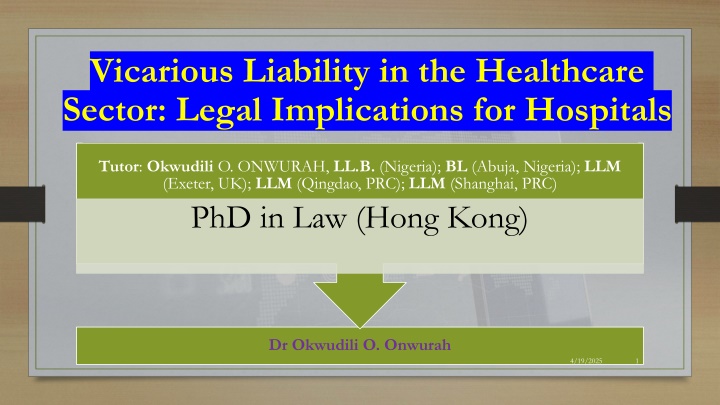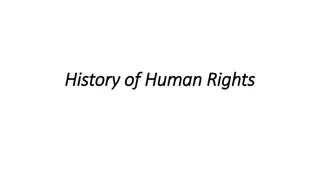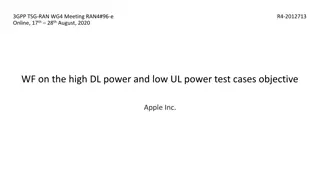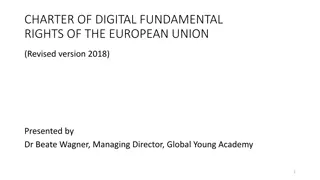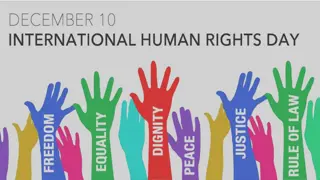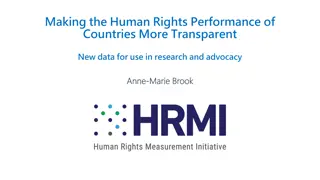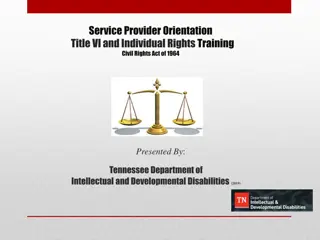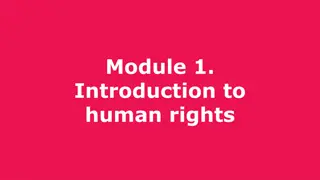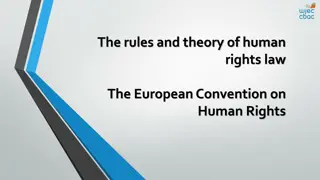Proposal Enhancements for Meeting Rights Management
This proposal suggests add-ons to the existing meeting rights mechanism, allowing for rights to be gained or lost based on consecutive meeting attendance. The algorithm retains current rules while introducing new criteria for gaining and losing rights. Advantages and disadvantages are discussed along with evaluations on how quickly an individual can gain or lose meeting rights under the proposed system.
Download Presentation

Please find below an Image/Link to download the presentation.
The content on the website is provided AS IS for your information and personal use only. It may not be sold, licensed, or shared on other websites without obtaining consent from the author.If you encounter any issues during the download, it is possible that the publisher has removed the file from their server.
You are allowed to download the files provided on this website for personal or commercial use, subject to the condition that they are used lawfully. All files are the property of their respective owners.
The content on the website is provided AS IS for your information and personal use only. It may not be sold, licensed, or shared on other websites without obtaining consent from the author.
E N D
Presentation Transcript
Vicarious Liability in the Healthcare Sector: Legal Implications for Hospitals Tutor: Okwudili O. ONWURAH, LL.B. (Nigeria); BL (Abuja, Nigeria); LLM (Exeter, UK); LLM (Qingdao, PRC); LLM (Shanghai, PRC) PhD in Law (Hong Kong) Dr Okwudili O. Onwurah 4/19/2025 1
The purpose of the online lesson is to encourage you to participate actively in achieving your needs and simplifying your legal education. I want you to be the best! Will make the learning process more interactive discussions and feel free to ask any question or you can speak. Minor House Keeping You have the right to choose whether to turn on your video or not. Participation prepares you for your exam and learning needs with ease. 4/19/2025 2
Introduction The conceptof vicarious liabilityplays a crucialrole inshaping the legal landscape of the healthcare sector, particularly concerning hospitals' responsibilitiesfor the actions of their staff. This presentation delves into the intricate web of legal principles,case law, and practicalimplicationssurrounding vicarious liabilityinhealthcare settings. We will explorehow this doctrineaffects hospitals, medicalprofessionals, and patients alike, drawing upon relevant English and Hong Kong cases to illustratekey points. By examining the nuances of vicarious liability,we aim to provide a comprehensiveunderstanding of its impacton healthcare delivery and risk management inmodern medicalinstitutions. 3
Overview of Vicarious Liability in Healthcare Definition 1 Vicariousliability in healthcare refers to the legal principlewhere a hospital or healthcare institution can be held responsiblefor the negligent actions of its employees. This conceptstems fromthe Latin maxim 'respondeat superior', meaning 'let the master answer'. Historical Context 2 The doctrinehas evolved significantly over the years, with early cases in the 19th century establishing the foundationsforemployerliability. Inhealthcare, this has been particularlyimportant due to the high-stakes nature of medical treatment. Modern Application 3 Today, vicarious liability extends beyond traditional employer-employee relationships, encompassing various healthcare scenarios and reflecting the complexorganisational structures ofmodernhospitals. 4
Key Legal Principles: Duty of Care and Employer Control Dutyof Care Employer Control Scope of Employment The foundation of vicarious liability in healthcare is the duty of care owed by medical professionals to their patients. This duty extends to the hospital through the principle of vicarious liability. The landmark case of Donoghue v Stevenson[1932] AC 562 established the 'neighbour principle', which has been applied in healthcare contexts to define the scope of duty. The degree of control an employer exercises over its employees is a crucial factor in determining vicarious liability. In healthcare, this can be complex due to the autonomous nature of medical professionals' work. The case of Various Claimants v Catholic Child Welfare Society [2012] UKSC 56 expanded the concept of control, considering factors beyond direct supervision. Acts must be within the scope of employment for vicarious liability to apply. The case of Lister v Hesley Hall Ltd [2001] UKHL22 broadened this concept, considering whether the employee's act wasclosely connected to their authorised duties. 5
Case Law: Cassidy v Ministry of Health (1951) Case Summary LegalPrincipleEstablished Cassidy v Ministry of Health[1951] 2 KB 343 is a seminal case TheCourtof Appealheldthat thehospital was vicariously in the developmentof vicarious liability in healthcare.The liable for thenegligence of its medical staff, including both claimant, Mr Cassidy, underwenthand surgeryat a hospital employedand contracteddoctors.This decision expanded managed by theMinistry of Health. Following the operation, thescopeof hospital liability significantly. his handwas left stiff and useless. Reasoning Impact Thecourtreasonedthatthe hospital hadundertakento treat This case set a precedentfor holding hospitals responsible the patientand hadselectedthemedical staff. Therefore,it fortheactions of medical professionals workingwithin their was liable for the staff's negligence, regardlessof whether facilities,significantly influencing subsequenthealthcare they were employeesor independentcontractors. liability cases. 6
Hong Kong Example: Private Hospital Liability Provisions Legislative Framework VicariousLiability Application Case Example 1 2 3 Hong Kong's approachto private While not explicitly using theterm In Tai Sing Lam v. Hospital hospital liability is governedbythe 'vicarious liability', theOrdinance Authority[2016] HKCFI1317, the PrivateHealthcareFacilities imposes responsibilities on private Hong Kong Courtof First Instance Ordinance(Cap. 633). This hospitals for theactions of their appliedprinciples of vicarious legislation, enactedin 2018, aims to staff. Section 85 oftheOrdinance, liability to holdtheHospital enhancethe regulatoryregime for forinstance, holds thelicensee of a Authorityresponsiblefor the privatehealthcarefacilities, privatehospital responsible for negligent actions of its employed including provisions relatedto contraventions of the Ordinance by doctor.This case demonstratesthe liability. its employeesor agents. alignment of Hong Kong's approach with English common law principles. 7
Liability for Acts of Doctors vs. Nurses Aspect Doctors Nurses Often independent Usually direct EmploymentStatus contractors employees Scope of Liability Complex,case- Generally,more dependent straightforward Woodland v Mersey Docks and Key Case Law SwimmingTeachers HarbourBoard v Association[2013] Coggins & Griffith (Liverpool) Ltd[1947] UKSC 66 AC 1 Limitedin clinical Higher degree of HospitalControl decisions control 8
Independent Contractor Issues in Healthcare TraditionalRule EvolvingJurisprudence HealthcareApplication Future Implications Historically, hospitalswere not heldliable for the actions of independentcontractors, such as consulting physicians. This was based on the principle that hospitals did not exercise control overthese professionals'clinical decisions. Recentcase law has challengedthis traditional view. In Barclays Bank plc v VariousClaimants [2020] UKSC13, theSupremeCourt consideredthe natureof the relationshipand the integrationof thecontractor into theorganisation's business. In healthcare,courtsnow consider factorssuchas the hospital's portrayalof the doctorto patients, thelevel of integrationinto hospital systems, and thedegreeof controlexercisedover non- clinical matters. This evolving approachmay leadto increasedliability for hospitals,necessitating carefulconsideration of contractor agreementsand patientcommunication regardingthe status of medical professionals. 9
Practical Implications: Policies and Training Policy Development StaffTraining Hospitals must developcomprehensive policiesaddressing vicarious liabilityrisks. These shouldcover areas such as staff supervision, quality controlmeasures,and cleardelineation of responsibilities. Regulartraining sessionson legal responsibilities, proper documentation, and patient communication are essential. This helpsmitigate risks and ensures staff awareness of their rolesin preventing liability issues. Risk Assessment InsuranceCoverage Implementingrobust risk assessment protocolshelpsidentify potential liability hotspots. Thisproactive approachallows hospitals to address issues beforethey escalate into legalproblems. Adequateinsurance coverage is crucial. Hospitals shouldregularly review and update their policiesto ensure they coverevolving vicarious liability risks in the healthcare sector. 10
The Role of Vicarious Liability in Medical Negligence Claims Initial Assessment 1 When a medicalnegligenceclaimarises, lawyers assess whether vicarious liabilityapplies. This involves examiningthe relationship between the hospital and the healthcare professional involved in the incident. Establishing Negligence 2 The claimant must first prove that the healthcare professional was negligent. This typically involves demonstrating a breach of the duty of care, as established in Bolam v Friern Hospital Management Committee[1957] 1 WLR 582. Linking to Hospital 3 Once negligence is established, the link to the hospital through vicarious liabilityis examined. This may involve considering factors such as employmentstatus, degree of control,and integration into the hospital's operations. Compensation and Settlements 4 Vicarious liabilityoften leads to hospitals beingthe primary defendants inmedicalnegligencecases. This can affect settlementnegotiationsand compensationamounts, as hospitals typicallyhave greater financialresources than individual practitioners. 11
Interactive Scenario 1: Emergency Room Mishap Scenario Legal Question A patientis broughtto the emergencyroomwith severe Is thehospital vicariously liable forthe locum doctor's abdominal pain. Theon-dutydoctor,a locum physician negligence in this emergencyroomscenario? contractedby thehospital,misdiagnoses theconditionas indigestion. Thepatientis sent homebut latersuffersa rupturedappendix,requiringemergencysurgery. Considerations PotentialOutcome Thecourtwould likely considerfactors such as the level of Given recenttrendsin case law, there'sa strong possibility integrationof thelocum doctorinto thehospital's emergency thatthe hospital couldbe heldvicariously liable, especially if services, the degree ofcontrol exercisedby thehospital over the locum doctorwas fully integratedinto the ER team and ER procedures,and how the doctorwas presentedto following hospital protocols. patients. 12
Interactive Scenario 2: Surgical Team Error Scenario Details Legal Analysis PotentialOutcome During a routine hip replacement This scenario presents a complex A court might find the hospital surgery, a senior consultant surgeon, interplay of vicarious liability vicariously liable for the junior who is an independent contractor, principles. The hospital may argue doctor's negligence in failing to notice makes an error. However, it's the that the senior surgeon, as an the error. Additionally, there could be employedjunior doctor assisting who independent contractor, absolves an argument for the hospital's non- fails to notice and correct the mistake, them of liability. However, the junior delegable duty of care to the patient, leading to post-operative doctor's involvement complicates potentially extending liability to cover complications for the patient. matters. The case of Woodland v the independent surgeon's actions as Swimming Teachers Association well. This case highlights the complex [2013]UKSC 66 might be relevant, as it nature of vicarious liability in team- discussesthe concept of non- based medical procedures. delegable duty of care in certain scenarios. 13
Interactive Scenario 3: Nursing Home Care 1 2 3 4 Incident Legal Considerations RelevantCaseLaw PotentialOutcome An elderlypatientin a The case raises questions Coxv Ministry of Justice A courtmight hold the privatenursing home aboutthe extentof [2016] UKSC10 might be nursing home vicariously suffersseverebedsores vicarious liability in long- applicable,as it expanded liable for boththe nurses due to inadequatecare. termcaresettings. The the scope of vicarious and thephysiotherapist, nursing home'sliability for liability beyondtraditional considering theintegrated The negligence is tracedto boththe employednurses employednurses is employmentrelationships. natureof care provided relativelystraightforward, and the home'soverall and a visiting but theindependent responsibility forpatient physiotherapist who is an physiotherapist's status welfare. independent contractor. complicatesmatters. 14
Interactive Scenario 4: Telemedicine Consultation Scenario Setup Medical Aspect Legal Considerations PotentialRuling A hospital offers The misdiagnosis leads to a This scenario raises novel A court might hold the telemedicine services using delay in treatment for a questionsabout vicarious hospitalvicariouslyliable a platform provided by a serious condition,resulting liability in digital healthcare. for the doctor's negligence, third-party tech company. in significant harm to the The hospital's responsibility but could also consider the patient. The error is for its employed doctor is tech company's role. This A patient receives an incorrect diagnosis during a attributed to the limitations clear, but the involvement case could set new of the telemedicine of the third-party tech precedents forliabilityin video consultation with a platform and the doctor's platform complicates telemedicine services. doctor employed by the failuretorecommend an matters. hospital but working from in-person follow-up. home. 15
Interactive Scenario 5: Hospital Volunteer Programme Scenario Context A hospitalruns a volunteerprogramme where communitymembersassist withnon-medicaltasks likepatientguidance and meal distribution.A volunteer accidentallygives a patient with dietary restrictionsthe wrong meal, causing an allergicreaction. Legal Question Can the hospital be heldvicariouslyliablefor the actions of unpaid volunteers? Thisscenario teststhe boundaries of vicarious liability beyond traditionalemploymentrelationships. RelevantPrecedent The case of JGE v The Trustees of the Portsmouth Roman CatholicDiocesan Trust [2012]EWCA Civ 938 might be relevant, as it dealt with vicarious liability in the context of non-traditional 'employment' relationships. Potential Outcome A court might considerfactors such as the level of controlthe hospitalexercisedover volunteers, the integrationof volunteers into hospital operations, and public policyconsiderationsregarding volunteerprogrammes inhealthcare settings. 16
Conclusion: The Future of Vicarious Liability in Healthcare Expanding Scope Technological Challenges 1 2 The trend in recent case law suggests a broadening scope of The rise of telemedicine, AI-assisted diagnostics, and other vicarious liability in healthcare. Courts are increasingly willing technological advancements in healthcare will likely present to hold hospitals responsible for a wider range of individuals new challenges in determining the boundaries of vicarious working within their premises, including certain independent liability. Future cases may need to address issues of liability for contractors andvolunteers. errors in AI algorithms or telemedicine platforms. PolicyImplications Balancing Act 3 4 As vicariousliability continues to evolve, hospitals and The future development of vicarious liability in healthcare will healthcare providers will need to adapt their policies, training require a careful balancing act between ensuring patient programmes, and contractual arrangements. This may lead to protection and maintaining a fair and sustainable operating more comprehensive risk management strategies and environment for healthcare providers. This balance will likely potentially impact the structure of healthcare delivery models. be shaped by both judicial decisions and legislative interventions in the coming years. 17
